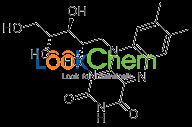- 0086-21-56469616
- 0086-18019205509
- minstar@minstargroup.com
- Language:English
- English
Your Location:Home >Products >Pharmaceutical >83-88-5


Appearance:Yellow to orange/yellow crystalline powder
Throughput:20|Kilogram|Month
pd_productuse:Nutritional factor found in milk, eggs, malted barley, liver, kidney, heart, leafy vegetables. Richest natural source is yeast. Minute amounts present in all plant and animal cells. Vitamin (enzyme co
Delivery Time:in stock
Purity:USP23
【Synonyms】
6,7-Dimethyl-9-D-ribitylisoalloxazine
Beflavine
Benzo(g)pteridine-2,4(3H,10h)-dione, 7,8-dimethyl-10-(d-ribo-2,3,4,5-tetrahydroxypentyl)-6,7-dimethyl-9-d-ribitylisoalloxazine
Isoalloxazine, 7,8-dimethyl-10-D-ribityl-
Riboflavine
Vitamin B2
【CAS】
83-88-5
【Formula】
C17H20N4O6
【Molecular Weight】
376.37
【EINECS】
201-507-1
【RTECS】
VJ1400000
【RTECS Class】
Drug; Mutagen
【Merck】
12,8367
【Beilstein/Gmelin】
97825
【Beilstein Reference】
4-26-00-02542
Physical and Chemical Properties Back to Contents
【Appearance】
Fine orange-yellow needles. or powder.
【Solubility in water】
0.1 g/L
【Melting Point】
280
【pKa/pKb】
4.32 (pKa)
【Partition Coefficient】
-1.46
【Usage】
Inhibitor of poly(ethylene glycol) oxidation.
First Aid Measures Back to Contents
【Ingestion】
If victim is conscious and alert, give 2-4 cupfuls of milk or water. Never give anything by mouth to an unconscious person. Get medical aid.
【Inhalation】
Remove from exposure to fresh air immediately. If not breathing, give artificial respiration. If breathing is difficult, give oxygen. Get medical aid.
【Skin】
Flush skin with plenty of soap and water for at least 15 minutes while removing contaminated clothing and shoes. Get medical aid if irritation develops or persists.
【Eyes】
Flush eyes with plenty of water for at least 15 minutes, occasionally lifting the upper and lower eyelids. Immediately flush eyes with plenty of water for at least 15 minutes, occasionally lifting the upper and lower eyelids. Get medical aid.
Handling and Storage Back to Contents
【Storage】
Store in a tightly closed container. Store below 40C. Store protected from light. Store in a cool, dry area away from incompatible substances.
【Handling】
Use with adequate ventilation. Avoid contact with skin and eyes. Keep container tightly closed. Avoid ingestion and inhalation. Store protected from light. Wash clothing before reuse.
Hazards Identification Back to Contents
【Ingestion】
Ingestion of large amounts may cause gastrointestinal irritation. Low hazard for usual industrial handling.
【Inhalation】
May cause respiratory tract irritation. Low hazard for usual industrial handling.
【Skin】
May cause skin irritation.
【Eyes】
May cause eye irritation.
Exposure Controls/Personal Protection Back to Contents
【Personal Protection】
Eyes: Wear appropriate protective eyeglasses or chemical safety goggles as described by OSHA's eye and face protection regulations in 29 CFR 1910.133 or European Standard EN166. Skin: Wear appropriate protective gloves and clothing to prevent skin exposure. Clothing: Wear appropriate protective clothing to minimize contact with skin.
【Respirators】
A respiratory protection program that meets OSHA's 29 CFR 1910.134 and ANSI Z88.2 requirements or European Standard EN 149 must be followed whenever workplace conditions warrant a respirator's use.
【Poison Class】
F (Not subject to toxicity classification)
Fire Fighting Measures Back to Contents
【Fire Fighting】
Wear a self-contained breathing apparatus in pressure-demand, MSHA/NIOSH (approved or equivalent), and full protective gear. During a fire, irritating and highly toxic gases may be generated by thermal decomposition or combustion. Dust can be an explosion hazard when exposed to heat or flame. To extinguish fire, use water, dry chemical, chemical foam, or alcohol-resistant foam.
Accidental Release Measures Back to Contents
【Small spills/leaks】
Vacuum or sweep up material and place into a suitable disposal container. Clean up spills immediately, using the appropriate protective equipment. Sweep up or absorb material, then place into a suitable clean, dry, closed container for disposal. Avoid generating dusty conditions. Provide ventilation.
Stability and Reactivity Back to Contents
【Stability】
Stable under normal temperatures and pressures. May decompose on exposure to moist air or water. Darkens on exposure to light.
【Incompatibilities】
Strong oxidizing agents, reducing agents, bases, metallic salts, calcium, moisture, direct light.
【Decomposition】
Nitrogen oxides, carbon monoxide, oxides of phosphorus, carbon dioxide.
Transport Information Back to Contents
【HS Code】
2936 23 00
CAS:885523-08-0
CAS:517920-73-9
CAS:13813-45-1